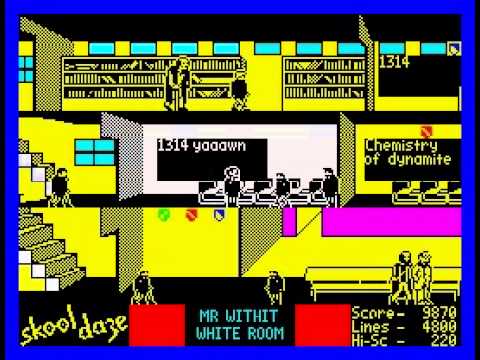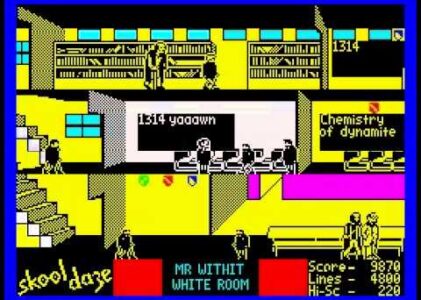Embark on a nostalgic journey into the past with “Skool Daze,” a groundbreaking video game that left an indelible mark on the gaming landscape. Delve into its unique genre, captivating gameplay, key features, critical reviews, cultural impact, sequels, and kindred titles that share its essence.
Introduction
In the annals of video game history, certain titles stand as pillars, representing the evolution of the medium. “Skool Daze,” a game that redefined the possibilities of interactive entertainment, is undoubtedly one such pillar. Combining innovative gameplay mechanics with a distinctive setting, “Skool Daze” captured the hearts of players upon its release. This article takes you on a voyage through the enchanting world of “Skool Daze,” exploring its genre, platforms, gameplay, features, reviews, cultural influence, sequels, and analogous games that carried its torch.
Unveiling the Genre and Platforms of Skool Daze
“Skool Daze” carved its niche in the genre of action-adventure games, offering a unique blend of puzzle-solving, exploration, and strategic thinking. Developed by David Reidy and released by Microsphere in 1984, this seminal title made its debut on the ZX Spectrum platform. As the popularity of “Skool Daze” surged, it was subsequently ported to other platforms, including the Commodore 64, Amstrad CPC, and MSX.
Embarking on the Gameplay Odyssey
The heart of “Skool Daze” beats within its captivating gameplay. Players assume the role of Eric, a mischievous schoolboy tasked with an audacious mission: to retrieve his report card from the school’s staff room. However, the school environment is anything but ordinary. With a unique day-night cycle and intricate characters, the game challenges players to navigate the complexities of student life.
Key Gameplay Features
Dynamic Schedule
Unlike many contemporaneous games, “Skool Daze” introduced a dynamic schedule that mimicked the daily routine of a school. Players had to attend classes, avoid teachers, interact with classmates, and undertake activities within a limited timeframe. This innovative mechanic injected realism and urgency into the game.
Character Interaction
Central to the game’s appeal was the ability to interact with the vibrant cast of characters. Players could communicate with fellow students, exchange items, and manipulate the behavior of both teachers and peers to achieve their objectives. This interaction mechanic elevated the gameplay from mere puzzle-solving to a dynamic social experiment.
Puzzles and Strategy
Navigating the school’s corridors and classrooms involved more than physical movement. Players needed to solve puzzles, devise strategies, and utilize their wits to overcome obstacles. The game encouraged creative problem-solving and rewarded players who could devise cunning schemes.
Reviews and Cultural Impact
Upon its release, “Skool Daze” garnered widespread acclaim from both players and critics alike. Its revolutionary approach to gameplay mechanics and the innovative use of an educational setting captivated audiences. Critics hailed its dynamic schedule and interactive elements, citing them as groundbreaking contributions to the gaming landscape.
The impact of “Skool Daze” extended far beyond its critical reception. It served as a catalyst for the fusion of education and entertainment in gaming, inspiring developers to explore unconventional settings and mechanics. The game’s legacy can be observed in subsequent titles that adopted similar principles, blurring the line between learning and play.
Sequels and the Ripple Effect
The success of “Skool Daze” paved the way for a sequel, “Back to Skool,” released in 1985. This continuation further expanded the gameplay mechanics, offering players new challenges and interactions within the school environment. The sequel maintained the core elements that made the original a hit while introducing fresh content to satiate players’ hunger for more schoolyard escapades.
Kindred Spirits: Games with a Familiar Essence
The influence of “Skool Daze” resonated throughout the gaming industry, inspiring developers to craft experiences that mirrored its innovative spirit. “Bully,” released in 2006, transported players to a school setting where they navigated complex relationships, undertook missions, and explored an expansive open world.
“Undertale,” released in 2015, put players in the shoes of a child who fell into an underground world inhabited by monsters. Just as in “Skool Daze,” player choices and interactions had profound effects on the game’s narrative and outcomes.
Similarly, “Papers, Please,” a 2013 release, invited players to step into the role of a border control officer. Through decision-making and interaction, players could impact the lives of those seeking entry to the fictional country of Arstotzka. This echoes the agency players had in shaping the outcomes of “Skool Daze.”
Conclusion
“Skool Daze” remains a testament to the creativity and innovation that have fueled the evolution of video games. Its dynamic schedule, interactive characters, and thought-provoking puzzles laid the groundwork for a new era of gaming experiences. As players continue to explore the realms of virtual entertainment, they owe a debt of gratitude to “Skool Daze” for revolutionizing gameplay and expanding the possibilities of interactive storytelling.

